MASERATI GRANTURISMO 2019 Workshop Manual
Manufacturer: MASERATI, Model Year: 2019, Model line: GRANTURISMO, Model: MASERATI GRANTURISMO 2019Pages: 286, PDF Size: 8.08 MB
Page 51 of 286
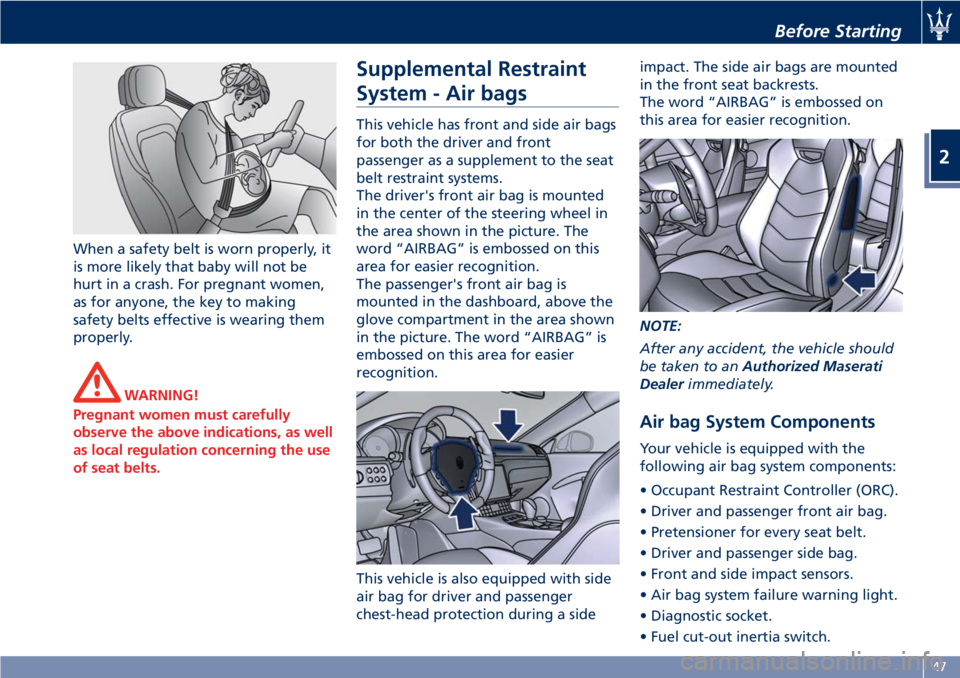
When a safety belt is worn properly, it
is more likely that baby will not be
hurt in a crash. For pregnant women,
as for anyone, the key to making
safety belts effective is wearing them
properly.
WARNING!
Pregnant women must carefully
observe the above indications, as well
as local regulation concerning the use
of seat belts. Supplemental Restraint
System - Air bags This vehicle has front and side air bags
for both the driver and front
passenger as a supplement to the seat
belt restraint systems.
The driver's front air bag is mounted
in the center of the steering wheel in
the area shown in the picture. The
word “AIRBAG” is embossed on this
area for easier recognition.
The passenger's front air bag is
mounted in the dashboard, above the
glove compartment in the area shown
in the picture. The word “AIRBAG” is
embossed on this area for easier
recognition.
This vehicle is also equipped with side
air bag for driver and passenger
chest-head protection during a side impact. The side air bags are mounted
in the front seat backrests.
The word “AIRBAG” is embossed on
this area for easier recognition.
NOTE:
After any accident, the vehicle should
be taken to an Authorized Maserati
Dealer immediately.
Air bag System Components Your vehicle is equipped with the
following air bag system components:
• Occupant Restraint Controller (ORC).
• Driver and passenger front air bag.
• Pretensioner for every seat belt.
• Driver and passenger side bag.
• Front and side impact sensors.
• Air bag system failure warning light.
• Diagnostic socket.
• Fuel cut-out inertia switch.Before Starting
2
47
Page 52 of 286
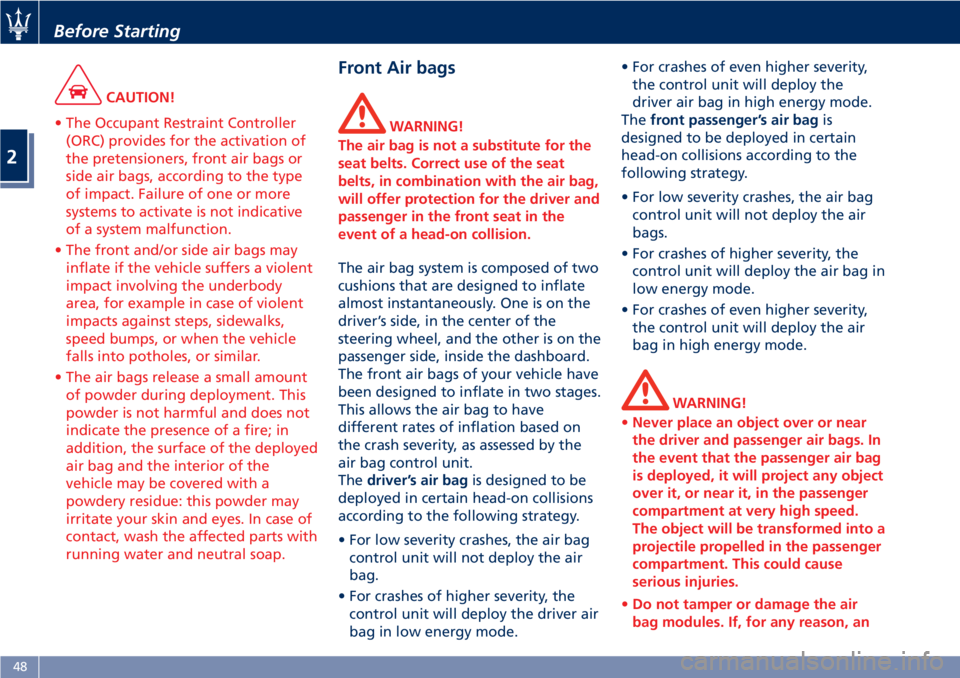
CAUTION!
• The Occupant Restraint Controller
(ORC) provides for the activation of
the pretensioners, front air bags or
side air bags, according to the type
of impact. Failure of one or more
systems to activate is not indicative
of a system malfunction.
• The front and/or side air bags may
inflate if the vehicle suffers a violent
impact involving the underbody
area, for example in case of violent
impacts against steps, sidewalks,
speed bumps, or when the vehicle
falls into potholes, or similar.
• The air bags release a small amount
of powder during deployment. This
powder is not harmful and does not
indicate the presence of a fire; in
addition, the surface of the deployed
air bag and the interior of the
vehicle may be covered with a
powdery residue: this powder may
irritate your skin and eyes. In case of
contact, wash the affected parts with
running water and neutral soap. Front Air bags WARNING!
The air bag is not a substitute for the
seat belts. Correct use of the seat
belts, in combination with the air bag,
will offer protection for the driver and
passenger in the front seat in the
event of a head-on collision.
The air bag system is composed of two
cushions
that are designed to inflate
almost instantaneously. One is on the
driver’s side, in the center of the
steering wheel, and the other is on the
passenger side, inside the dashboard.
The front air bags of your vehicle have
been designed to inflate in two stages.
This allows the air bag to have
different rates of inflation based on
the crash severity, as assessed by the
air bag control unit.
The driver’s air bag is designed to be
deployed in certain head-on collisions
according to the following strategy.
• For low severity crashes, the air bag
control unit will not deploy the air
bag.
• For crashes of higher severity, the
control unit will deploy the driver air
bag in low energy mode. • For crashes of even higher severity,
the control unit will deploy the
driver air bag in high energy mode.
The front passenger’s air bag is
designed to be deployed in certain
head-on collisions according to the
following strategy.
• For low severity crashes, the air bag
control unit will not deploy the air
bags.
• For crashes of higher severity, the
control unit will deploy the air bag in
low energy mode.
• For crashes of even higher severity,
the control unit will deploy the air
bag in high energy mode.
WARNING!
• Never place an object over or near
the driver and passenger air bags. In
the event that the passenger air bag
is deployed, it will project any object
over it, or near it, in the passenger
compartment at very high speed.
The object will be transformed into a
projectile propelled in the passenger
compartment. This could cause
serious injuries.
• Do not tamper or damage the air
bag modules. If, for any reason, anBefore Starting
2
48
Page 53 of 286
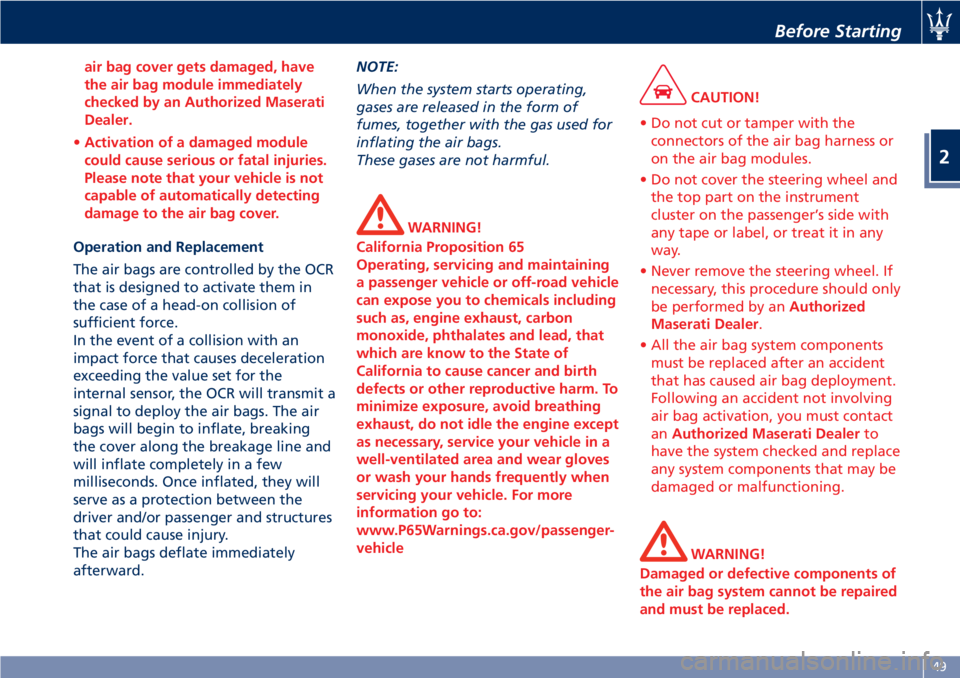
air bag cover gets damaged, have
the air bag module immediately
checked by an Authorized Maserati
Dealer.
• Activation of a damaged module
could cause serious or fatal injuries.
Please note that your vehicle is not
capable of automatically detecting
damage to the air bag cover.
Operation and Replacement
The
air bags are controlled by the OCR
that is designed to activate them in
the case of a head-on collision of
sufficient force.
In the event of a collision with an
impact force that causes deceleration
exceeding the value set for the
internal sensor, the OCR will transmit a
signal to deploy the air bags. The air
bags will begin to inflate, breaking
the cover along the breakage line and
will inflate completely in a few
milliseconds. Once inflated, they will
serve as a protection between the
driver and/or passenger and structures
that could cause injury.
The air bags deflate immediately
afterward. NOTE:
When the system starts operating,
gases are released in the form of
fumes, together with the gas used for
inflating the air bags.
These gases are not harmful.
WARNING!
California Proposition 65
Operating, servicing and maintaining
a passenger vehicle or off-road vehicle
can expose you to chemicals including
such as, engine exhaust, carbon
monoxide, phthalates and lead, that
which are know to the State of
California to cause cancer and birth
defects or other reproductive harm. To
minimize exposure, avoid breathing
exhaust, do not idle the engine except
as necessary, service your vehicle in a
well-ventilated area and wear gloves
or wash your hands frequently when
servicing your vehicle. For more
information go to:
www.P65Warnings.ca.gov/passenger-
vehicle CAUTION!
• Do not cut or tamper with the
connectors of the air bag harness or
on the air bag modules.
• Do not cover the steering wheel and
the top part on the instrument
cluster on the passenger’s side with
any tape or label, or treat it in any
way.
• Never remove the steering wheel. If
necessary, this procedure should only
be performed by an Authorized
Maserati Dealer .
• All the air bag system components
must be replaced after an accident
that has caused air bag deployment.
Following an accident not involving
air bag activation, you must contact
an Authorized Maserati Dealer to
have the system checked and replace
any system components that may be
damaged or malfunctioning.
WARNING!
Damaged or defective components of
the air bag system cannot be repaired
and must be replaced.Before Starting
2
49
Page 54 of 286
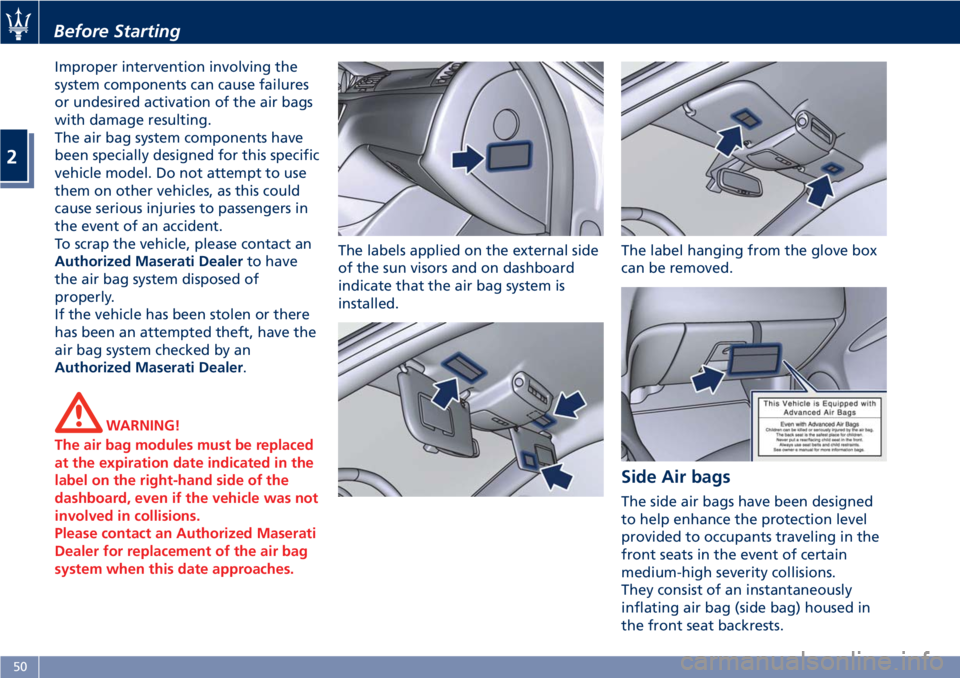
Improper intervention involving the
system components can cause failures
or undesired activation of the air bags
with damage resulting.
The air bag system components have
been specially designed for this specific
vehicle model. Do not attempt to use
them on other vehicles, as this could
cause serious injuries to passengers in
the event of an accident.
To scrap the vehicle, please contact an
Authorized Maserati Dealer to have
the air bag system disposed of
properly.
If the vehicle has been stolen or there
has been an attempted theft, have the
air bag system checked by an
Authorized Maserati Dealer .
WARNING!
The air bag modules must be replaced
at the expiration date indicated in the
label on the right-hand side of the
dashboard, even if the vehicle was not
involved in collisions.
Please contact an Authorized Maserati
Dealer for replacement of the air bag
system when this date approaches. The labels applied on the external side
of
the sun visors and on dashboard
indicate that the air bag system is
installed. The label hanging from the glove box
can be removed.
Side Air bags The side air bags have been designed
to help enhance the protection level
provided to occupants traveling in the
front seats in the event of certain
medium-high severity collisions.
They consist of an instantaneously
inflating air bag (side bag) housed in
the front seat backrests.Before Starting
2
50
Page 55 of 286
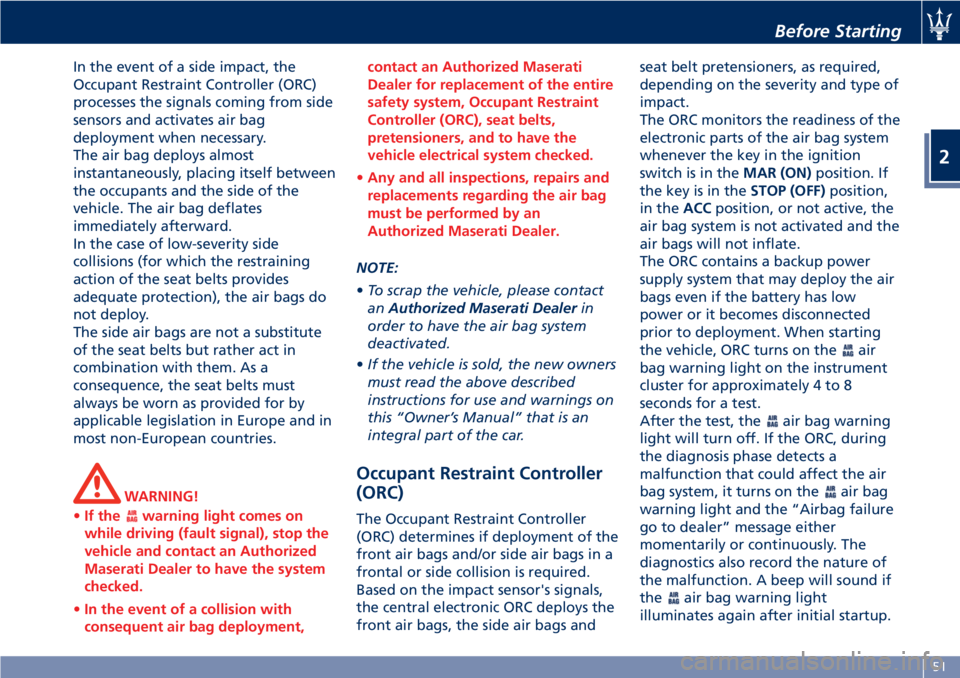
In the event of a side impact, the
Occupant Restraint Controller (ORC)
processes the signals coming from side
sensors and activates air bag
deployment when necessary.
The air bag deploys almost
instantaneously, placing itself between
the occupants and the side of the
vehicle. The air bag deflates
immediately afterward.
In the case of low-severity side
collisions (for which the restraining
action of the seat belts provides
adequate protection), the air bags do
not deploy.
The side air bags are not a substitute
of the seat belts but rather act in
combination with them. As a
consequence, the seat belts must
always be worn as provided for by
applicable legislation in Europe and in
most non-European countries.
WARNING!
• If the
warning light comes on
while driving (fault signal), stop the
vehicle and contact an Authorized
Maserati Dealer to have the system
checked.
• In the event of a collision with
consequent air bag deployment, contact an Authorized Maserati
Dealer for replacement of the entire
safety system, Occupant Restraint
Controller (ORC), seat belts,
pretensioners, and to have the
vehicle electrical system checked.
• Any and all inspections, repairs and
replacements regarding the air bag
must be performed by an
Authorized Maserati Dealer.
NOTE:
• T
o scrap the vehicle, please contact
an Authorized Maserati Dealer in
order to have the air bag system
deactivated.
• If the vehicle is sold, the new owners
must read the above described
instructions for use and warnings on
this “Owner’s Manual” that is an
integral part of the car.
Occupant Restraint Controller
(ORC) The Occupant Restraint Controller
(ORC) determines if deployment of the
front air bags and/or side air bags in a
frontal or side collision is required.
Based on the impact sensor's signals,
the central electronic ORC deploys the
front air bags, the side air bags and seat belt pretensioners, as required,
depending on the severity and type of
impact.
The ORC monitors the readiness of the
electronic parts of the air bag system
whenever the key in the ignition
switch is in the MAR (ON) position. If
the key is in the STOP (OFF) position,
in the ACC position, or not active, the
air bag system is not activated and the
air bags will not inflate.
The ORC contains a backup power
supply system that may deploy the air
bags even if the battery has low
power or it becomes disconnected
prior to deployment. When starting
the vehicle, ORC turns on the
air
bag warning light on the instrument
cluster for approximately 4 to 8
seconds for a test.
After the test, the
air bag warning
light will turn off. If the ORC, during
the diagnosis phase detects a
malfunction that could affect the air
bag system, it turns on the
air bag
warning light and the “Airbag failure
go to dealer” message either
momentarily or continuously. The
diagnostics also record the nature of
the malfunction. A beep will sound if
the
air bag warning light
illuminates again after initial startup.Before Starting
2
51
Page 56 of 286
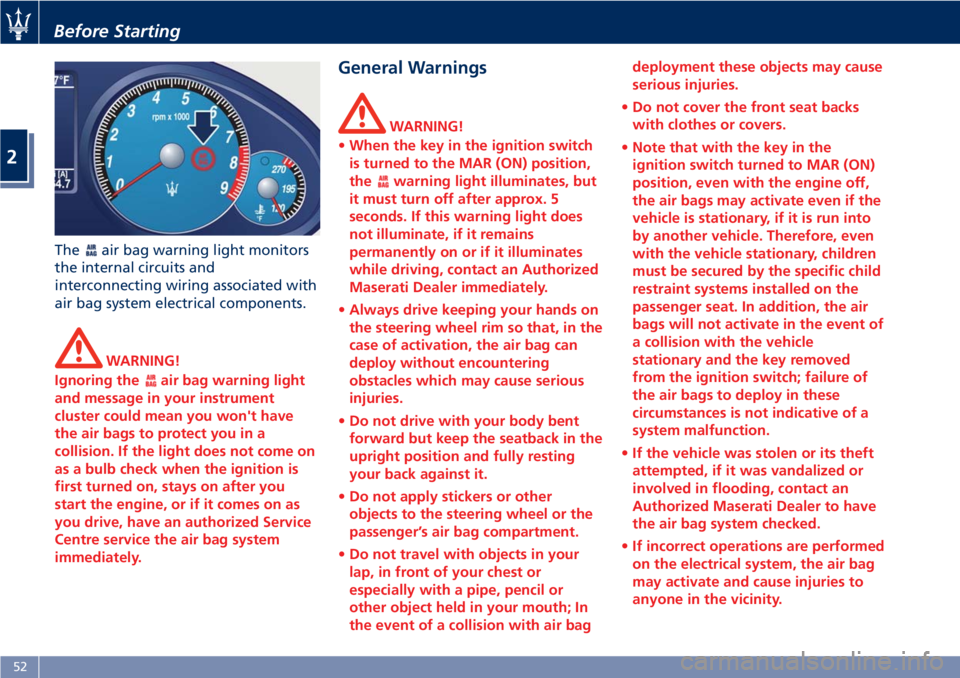
The air bag warning light monitors
the internal circuits and
interconnecting wiring associated with
air bag system electrical components.
WARNING!
Ignoring the
air bag warning light
and message in your instrument
cluster could mean you won't have
the air bags to protect you in a
collision. If the light does not come on
as a bulb check when the ignition is
first turned on, stays on after you
start the engine, or if it comes on as
you drive, have an authorized Service
Centre service the air bag system
immediately. General Warnings WARNING!
• When the key in the ignition switch
is turned to the MAR (ON) position,
the
warning light illuminates, but
it must turn off after approx. 5
seconds. If this warning light does
not illuminate, if it remains
permanently on or if it illuminates
while driving, contact an Authorized
Maserati Dealer immediately.
• Always drive keeping your hands on
the steering wheel rim so that, in the
case of activation, the air bag can
deploy without encountering
obstacles which may cause serious
injuries.
• Do not drive with your body bent
forward but keep the seatback in the
upright position and fully resting
your back against it.
• Do not apply stickers or other
objects to the steering wheel or the
passenger’s air bag compartment.
• Do not travel with objects in your
lap, in front of your chest or
especially with a pipe, pencil or
other object held in your mouth; In
the event of a collision with air bag deployment these objects may cause
serious injuries.
• Do not cover the front seat backs
with clothes or covers.
• Note that with the key in the
ignition switch turned to MAR (ON)
position, even with the engine off,
the air bags may activate even if the
vehicle is stationary, if it is run into
by another vehicle. Therefore, even
with the vehicle stationary, children
must be secured by the specific child
restraint systems installed on the
passenger seat. In addition, the air
bags will not activate in the event of
a collision with the vehicle
stationary and the key removed
from the ignition switch; failure of
the air bags to deploy in these
circumstances is not indicative of a
system malfunction.
• If the vehicle was stolen or its theft
attempted, if it was vandalized or
involved in flooding, contact an
Authorized Maserati Dealer to have
the air bag system checked.
• If incorrect operations are performed
on the electrical system, the air bag
may activate and cause injuries to
anyone in the vicinity.Before Starting
2
52
Page 57 of 286
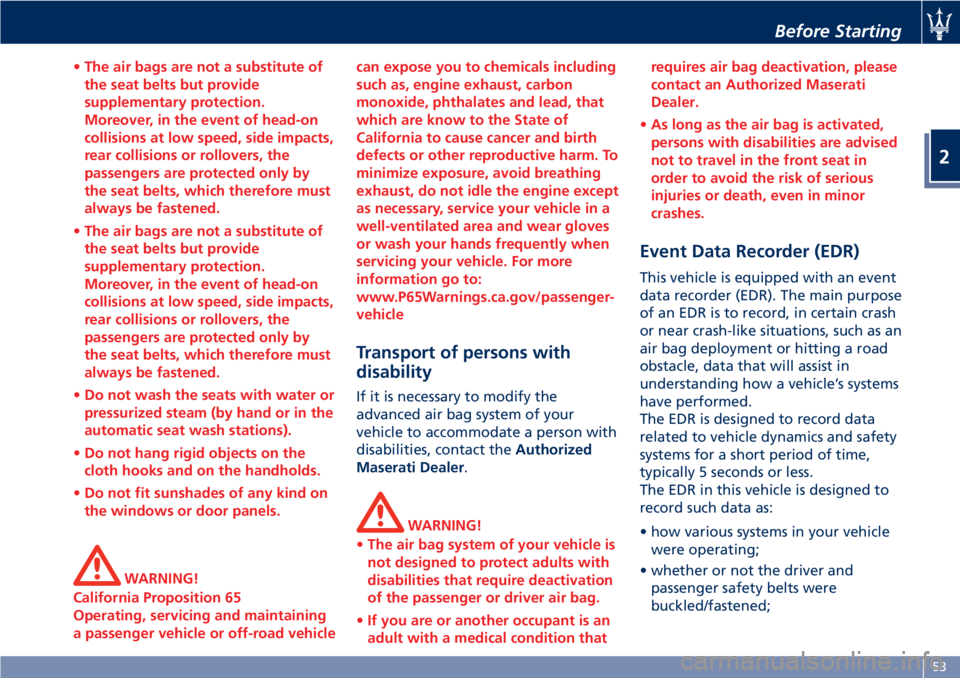
• The air bags are not a substitute of
the seat belts but provide
supplementary protection.
Moreover, in the event of head-on
collisions at low speed, side impacts,
rear collisions or rollovers, the
passengers are protected only by
the seat belts, which therefore must
always be fastened.
• The air bags are not a substitute of
the seat belts but provide
supplementary protection.
Moreover, in the event of head-on
collisions at low speed, side impacts,
rear collisions or rollovers, the
passengers are protected only by
the seat belts, which therefore must
always be fastened.
• Do not wash the seats with water or
pressurized steam (by hand or in the
automatic seat wash stations).
• Do not hang rigid objects on the
cloth hooks and on the handholds.
• Do not fit sunshades of any kind on
the windows or door panels.
WARNING!
California Proposition 65
Operating, servicing and maintaining
a passenger vehicle or off-road vehicle can expose you to chemicals including
such as, engine exhaust, carbon
monoxide, phthalates and lead, that
which are know to the State of
California to cause cancer and birth
defects or other reproductive harm. To
minimize exposure, avoid breathing
exhaust, do not idle the engine except
as necessary, service your vehicle in a
well-ventilated area and wear gloves
or wash your hands frequently when
servicing your vehicle. For more
information go to:
www.P65Warnings.ca.gov/passenger-
vehicle
Transport of persons with
disability If it is necessary to modify the
advanced air bag system of your
vehicle to accommodate a person with
disabilities, contact the Authorized
Maserati Dealer .
WARNING!
• The air bag system of your vehicle is
not designed to protect adults with
disabilities that require deactivation
of the passenger or driver air bag.
• If you are or another occupant is an
adult with a medical condition that requires air bag deactivation, please
contact an Authorized Maserati
Dealer.
• As long as the air bag is activated,
persons with disabilities are advised
not to travel in the front seat in
order to avoid the risk of serious
injuries or death, even in minor
crashes.
Event Data Recorder (EDR) This vehicle is equipped with an event
data recorder (EDR). The main purpose
of an EDR is to record, in certain crash
or near crash-like situations, such as an
air bag deployment or hitting a road
obstacle, data that will assist in
understanding how a vehicle’s systems
have performed.
The EDR is designed to record data
related to vehicle dynamics and safety
systems for a short period of time,
typically 5 seconds or less.
The EDR in this vehicle is designed to
record such data as:
• how various systems in your vehicle
were operating;
• whether or not the driver and
passenger safety belts were
buckled/fastened;Before Starting
2
53
Page 58 of 286
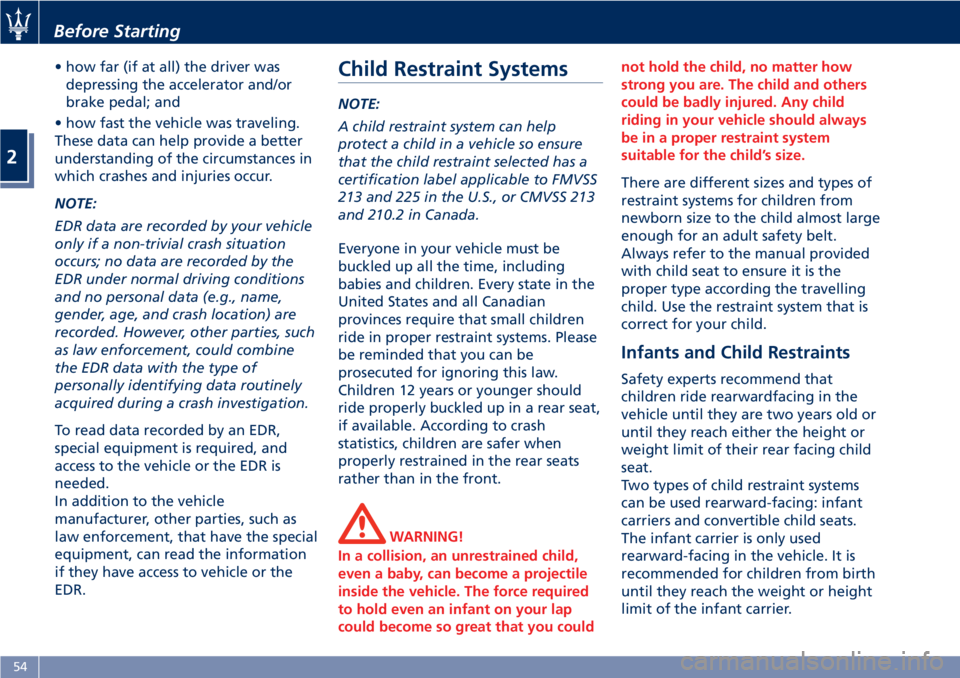
• how far (if at all) the driver was
depressing the accelerator and/or
brake pedal; and
• how fast the vehicle was traveling.
These data can help provide a better
understanding of the circumstances in
which crashes and injuries occur.
NOTE:
EDR data are recorded by your vehicle
only if a non-trivial crash situation
occurs; no data are recorded by the
EDR under normal driving conditions
and no personal data (e.g., name,
gender, age, and crash location) are
recorded. However, other parties, such
as law enforcement, could combine
the EDR data with the type of
personally identifying data routinely
acquired during a crash investigation.
To read data recorded by an EDR,
special equipment is required, and
access to the vehicle or the EDR is
needed.
In addition to the vehicle
manufacturer, other parties, such as
law enforcement, that have the special
equipment, can read the information
if they have access to vehicle or the
EDR. Child Restraint Systems NOTE:
A child restraint system can help
protect a child in a vehicle so ensure
that the child restraint selected has a
certification label applicable to FMVSS
213 and 225 in the U.S., or CMVSS 213
and 210.2 in Canada.
Everyone in your vehicle must be
buckled up all the time, including
babies and children. Every state in the
United States and all Canadian
provinces require that small children
ride in proper restraint systems. Please
be reminded that you can be
prosecuted for ignoring this law.
Children 12 years or younger should
ride properly buckled up in a rear seat,
if available. According to crash
statistics, children are safer when
properly restrained in the rear seats
rather than in the front.
WARNING!
In a collision, an unrestrained child,
even a baby, can become a projectile
inside the vehicle. The force required
to hold even an infant on your lap
could become so great that you could not hold the child, no matter how
strong you are. The child and others
could be badly injured. Any child
riding in your vehicle should always
be in a proper restraint system
suitable for the child’s size.
There are different sizes and types of
restraint
systems for children from
newborn size to the child almost large
enough for an adult safety belt.
Always refer to the manual provided
with child seat to ensure it is the
proper type according the travelling
child. Use the restraint system that is
correct for your child.
Infants and Child Restraints Safety experts recommend that
children ride rearwardfacing in the
vehicle until they are two years old or
until they reach either the height or
weight limit of their rear facing child
seat.
Two types of child restraint systems
can be used rearward-facing: infant
carriers and convertible child seats.
The infant carrier is only used
rearward-facing in the vehicle. It is
recommended for children from birth
until they reach the weight or height
limit of the infant carrier.Before Starting
2
54
Page 59 of 286
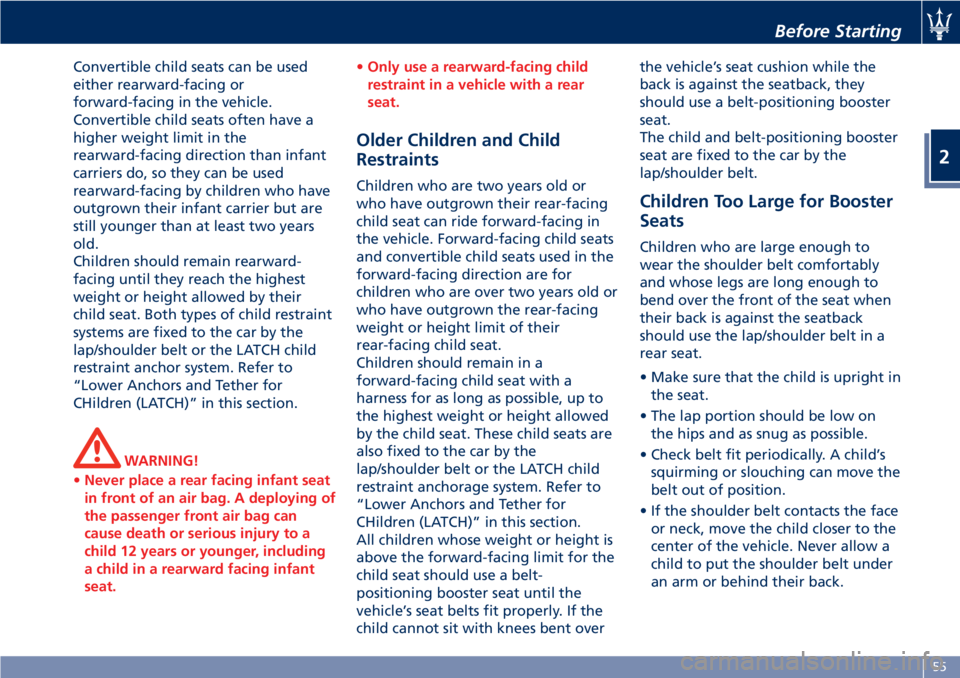
Convertible child seats can be used
either rearward-facing or
forward-facing in the vehicle.
Convertible child seats often have a
higher weight limit in the
rearward-facing direction than infant
carriers do, so they can be used
rearward-facing by children who have
outgrown their infant carrier but are
still younger than at least two years
old.
Children should remain rearward-
facing until they reach the highest
weight or height allowed by their
child seat. Both types of child restraint
systems are fixed to the car by the
lap/shoulder belt or the LATCH child
restraint anchor system. Refer to
“Lower Anchors and Tether for
CHildren (LATCH)” in this section.
WARNING!
• Never place a rear facing infant seat
in front of an air bag. A deploying of
the passenger front air bag can
cause death or serious injury to a
child 12 years or younger, including
a child in a rearward facing infant
seat. • Only use a rearward-facing child
restraint in a vehicle with a rear
seat.
Older Children and Child
Restraints Children who are two years old or
who have outgrown their rear-facing
child seat can ride forward-facing in
the vehicle. Forward-facing child seats
and convertible child seats used in the
forward-facing direction are for
children who are over two years old or
who have outgrown the rear-facing
weight or height limit of their
rear-facing child seat.
Children should remain in a
forward-facing child seat with a
harness for as long as possible, up to
the highest weight or height allowed
by the child seat. These child seats are
also fixed to the car by the
lap/shoulder belt or the LATCH child
restraint anchorage system. Refer to
“Lower Anchors and Tether for
CHildren (LATCH)” in this section.
All children whose weight or height is
above the forward-facing limit for the
child seat should use a belt-
positioning booster seat until the
vehicle’s seat belts fit properly. If the
child cannot sit with knees bent over the vehicle’s seat cushion while the
back is against the seatback, they
should use a belt-positioning booster
seat.
The child and belt-positioning booster
seat are fixed to the car by the
lap/shoulder belt.
Children Too Large for Booster
Seats Children who are large enough to
wear the shoulder belt comfortably
and whose legs are long enough to
bend over the front of the seat when
their back is against the seatback
should use the lap/shoulder belt in a
rear seat.
• Make sure that the child is upright in
the seat.
• The lap portion should be low on
the hips and as snug as possible.
• Check belt fit periodically. A child’s
squirming or slouching can move the
belt out of position.
• If the shoulder belt contacts the face
or neck, move the child closer to the
center of the vehicle. Never allow a
child to put the shoulder belt under
an arm or behind their back.Before Starting
2
55
Page 60 of 286
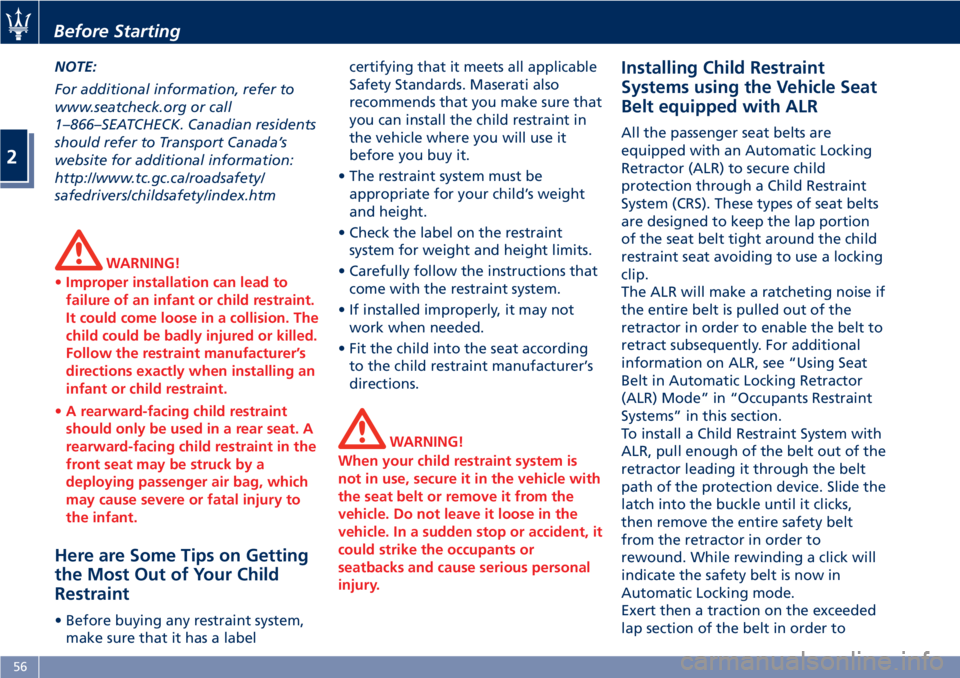
NOTE:
For additional information, refer to
www.seatcheck.org or call
1–866–SEATCHECK. Canadian residents
should refer to Transport Canada’s
website for additional information:
http://www.tc.gc.ca/roadsafety/
safedrivers/childsafety/index.htm
WARNING!
• Improper installation can lead to
failure of an infant or child restraint.
It could come loose in a collision. The
child could be badly injured or killed.
Follow the restraint manufacturer’s
directions exactly when installing an
infant or child restraint.
• A rearward-facing child restraint
should only be used in a rear seat. A
rearward-facing child restraint in the
front seat may be struck by a
deploying passenger air bag, which
may cause severe or fatal injury to
the infant.
Here are Some Tips on Getting
the Most Out of Your Child
Restraint
• Before buying any restraint system,
make sure that it has a label certifying that it meets all applicable
Safety Standards. Maserati also
recommends that you make sure that
you can install the child restraint in
the vehicle where you will use it
before you buy it.
• The restraint system must be
appropriate for your child’s weight
and height.
• Check the label on the restraint
system for weight and height limits.
• Carefully follow the instructions that
come with the restraint system.
• If installed improperly, it may not
work when needed.
• Fit the child into the seat according
to the child restraint manufacturer’s
directions.
WARNING!
When your child restraint system is
not in use, secure it in the vehicle with
the seat belt or remove it from the
vehicle. Do not leave it loose in the
vehicle. In a sudden stop or accident, it
could strike the occupants or
seatbacks and cause serious personal
injury. Installing Child Restraint
Systems using the Vehicle Seat
Belt equipped with ALR All the passenger seat belts are
equipped with an Automatic Locking
Retractor (ALR) to secure child
protection through a Child Restraint
System (CRS). These types of seat belts
are designed to keep the lap portion
of the seat belt tight around the child
restraint seat avoiding to use a locking
clip.
The ALR will make a ratcheting noise if
the entire belt is pulled out of the
retractor in order to enable the belt to
retract subsequently. For additional
information on ALR, see “Using Seat
Belt in Automatic Locking Retractor
(ALR) Mode” in “Occupants Restraint
Systems” in this section.
To install a Child Restraint System with
ALR, pull enough of the belt out of the
retractor leading it through the belt
path of the protection device. Slide the
latch into the buckle until it clicks,
then remove the entire safety belt
from the retractor in order to
rewound. While rewinding a click will
indicate the safety belt is now in
Automatic Locking mode.
Exert then a traction on the exceeded
lap section of the belt in order toBefore Starting
2
56